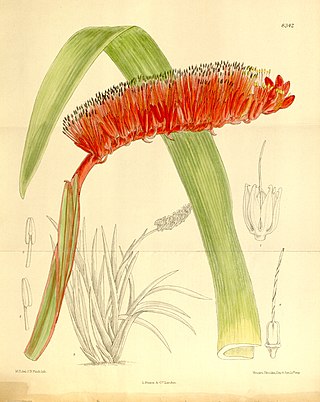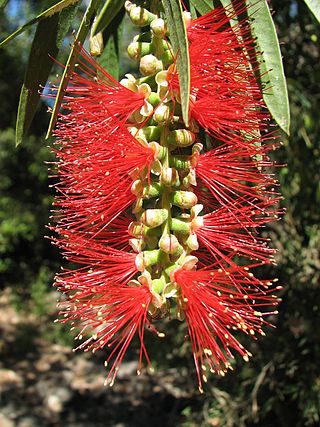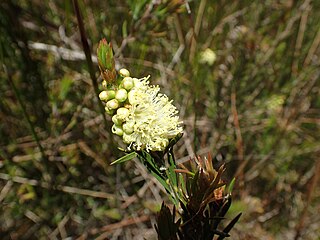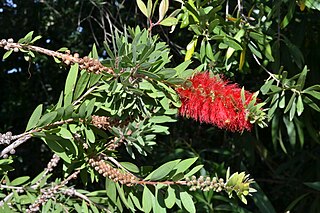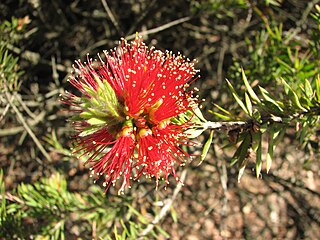This is a list of cultivars of the plant genus Callistemon .
Contents
| Cultivar | Image | Registration | Parentage and notes | Reference |
|---|---|---|---|---|
| (Austraflora cultivars) | listed by second name, e.g. 'Austraflora Firebrand' > 'Firebrand' | |||
| 'Bob Bailey' |  | ACRA, 1985 | Seedling of Callistemon viminalis | |
| 'Burgundy' |  | ACRA, 1967 | Seedling of Callistemon 'Reeves Pink' | |
| 'Candle Glow' |  | ACRA, 1985 | Seedling of Callistemon pallidus , also known as 'Austraflora Candle Glow' | |
| 'Cane's Hybrid' |  | |||
| 'Captain Cook' |  | |||
| 'Cinderella' |  | ACRA, 1981 | Garden origin, 1966 | |
| 'Country Sprite' | | ACRA, 1990 | Seedling of 'Glasshouse Country' | |
| 'Dawson River Weeper' |  | ACRA, 1984 | Form of Callistemon viminalis from Dawson River area, Queensland | |
| 'Demesne Rowena' |  | ACRA, 1982 | Cross of two Callistemon citrinus cultivars 'Splendens' and 'White Anzac' in 1979 | |
| 'Endeavour' | see 'Splendens' | |||
| 'Eureka' |  | |||
| 'Firebrand' |  | ACRA, 1979 | Originally registered as 'Austraflora Firebrand', seedling of unknown origin first planted in 1973 | |
| 'Glasshouse Country' |  | ACRA, 1985 | Cross between Callistemon sp. (Tinaroo) and Callistemon salignus | |
| 'Glasshouse Gem' |  | ACRA, 1985 | Cross between Callistemon sp. (Tinaroo) and Callistemon salignus , originated mid 1960s | |
| 'Hannah Ray' |  | |||
| 'Hannah's Child' |  | ACRA, 1992 | Cross between 'Hannah Ray' and 'Kings Park Special' selected in 1987 | |
| 'Harkness' |  | ACRA, 1974 | Also known as 'Gawler' or 'Gawler Hybrid'. Seedling of Callistemon citrinus obtained in 1937 | |
| 'Jeffersii' |  | |||
| 'Kempsey' |  | ACRA, 1987 | Seedling of 'Maffra Pastel Pink' | |
| 'Kings Park Special' |  | ACRA, 1980 | Seedling of unknown origin raised in Kings Park, Perth | |
| 'Lilacinus' |  | |||
| 'Little John' |  | Dwarf shrub selected by Ken Dunstan of Alstonville, New South Wales | [1] | |
| 'Mary MacKillop' |  | 'Hannah Ray' x 'Splendens'. Released by Austraflora in 2001. | [2] | |
| 'Matthew Flinders' |  | PBR, 2005 | ||
| 'Mauve Mist' |  | ACRA, 1967 | Seedling of 'Reeves Pink' | |
| 'Moonbeam' | see 'White Anzac' | |||
| 'Ngungun Red' |  | ACRA, 1988 | Also known as 'Ngun Ngun', seedling of Callistemon recurvus x Callistemon salignus first planted in 1981 | |
| 'Packers Selection' |  | ACRA, 1980 | Seedling from Callistemon subulatus | |
| 'Perth Pink' |  | ACRA, 1993 | Seedling selection of Callistemon salignus c. 1960 | |
| 'Pink Sensation' |  | ACRA, 1991 | Seedling of 'Glasshouse Gem' | |
| 'Prolific' |  | ACRA, ? | Form of Callistemon viminalis from Dalby, Queensland | |
| 'Red Reika' |  | ACRA, 1984 | Seedling selection from 'Harkness' | |
| 'Reeves Pink' |  | ACRA, 1967 | Seedling of unknown parentage from Cheltenham, Victoria; shares characteristics with Callistemon citrinus | |
| 'Rose Opal' |  | ACRA, 1980 | Selected form of Callistemon viminalis from Wappa Falls on the Maroochy River, Queensland (1956) | |
| 'Sallyann' |  | ACRA, 1983 | Selected pink-flowered form of Callistemon paludosus | |
| 'Smoked Salmon' |  | ACRA, ? | Selected pink-flowering form of Callistemon pachyphyllus from Runaway Bay, Queensland, first cultivated in 1976 | |
| 'Splendens' |  | ACRA, 1989 | A form of Callistemon citrinus of unknown origin, promoted in 1970 under the name 'Endeavour' by the Australian nursery industry | |
| 'Tin-Sal Glow' |  | ACRA, 1989 | Thought to be a hybrid of 'Glasshouse Country' and Callistemon recurvus (Tinaroo). | |
| 'Western Glory' |  | ACRA, 1980 | Seedling of Callistemon citrinus selected in Wanneroo, Western Australia | |
| 'White Anzac' |  | ACRA, 1981 | White-flowering form selected from a naturally occurring population in New South Wales. The cultivar 'Moonbeam' registered in 1964 is regarded as a synonym | |
| 'Wilderness White' |  | ACRA, 1985 | White-flowering naturally occurring form from Copper Load Falls Dam, north Queensland. | |
| 'Wollumbin' |  | ACRA, 1978 | Salmon-flowering form of Callistemon viminalis raised in Wollumbin, New South Wales | |
| 'Woolomin Sparkler' |  | ACRA, 1991 | Hybrid of a pink-flowering form of Callistemon salignus and 'Harkness' or Callistemon citrinus selected in 1987 |

